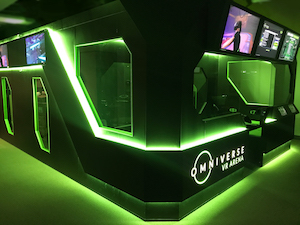Virtuix, developer of the Omni virtual reality treadmill and VR Arena esports attraction, announced that its Omniverse gaming platform has hit one million plays and 20 games.

Omniverse is the cloud-based content distribution and arcade management platform included with each Omni motion platform and VR Arena attraction. Commercial operators use Omniverse to run Omni games and track revenue stats.
All games on Omniverse are optimised both for the Omni and for location-based entertainment. Virtuix has shipped more than 3,000 Omni units to date to over 500 LBE locations in 45 countries.
Having reached the million-play milestone, Virtuix has shared six key lessons learned from running VR at LBE venues:
1. Offer better games, not more games. Omniverse gameplay data shows that 80 per cent of operator revenues come from only 20 per cent of games. In other words, of the 20 Omniverse games, 4 account for 80 per cent of revenues. The 10 least popular games on the platform generate only 6 per cent of revenues.
2. Shooters and ease-of-play are key. Eight of the ten most popular Omniverse games are shooting games. The second most requested genre is horror, the top choice among women. In third place are kid’s games. The most important game characteristic, reported by 79 per cent of Omni operators, is simple, easy-to-learn controls. The ideal game is “easy to play, difficult to master.”
3. Self-consciousness is the biggest hurdle. The number-one hesitation that drives customers away, as reported in a survey of VR operators, is that “guests are shy or uncomfortable about playing while people are watching.” Although providing more privacy for players may diminish an attraction’s visual draw, it may increase the number of guests who end up trying it.
4. Selecting the right staff is critical. Throughout their VR experience, guests need lots of handholding by attendants who are socially engaging and comforting to players. Many operators assign their most technically-minded staff as VR attendants, or their resident gaming fanatics. This choice may be a mistake, as these employees may not be the most personable.
5. Operational simplicity is necessary. A player-to-attendant ratio of at least 4:1 is essential to achieve acceptable ROI. Semi-automated operation and a predetermined player flow are necessary to keep throughput high (at least 20 players per hour). Well-designed attractions follow a steady cadence, with groups of players entering and exiting in a synchronous manner.
6. Ultimately, it’s not about VR. Although guests may be initially curious to try VR, the novelty wears off fast. To attract repeat players, an anchor VR attraction needs to be active, multiplayer, and competitive. Esports is a great way to add an addictive competitive element to VR, stimulating repeat play and enabling operators to build a local community of return players.
A full report of Virtuix’s lessons learned from one million Omniverse plays can be found on the company’s blog on it website.
“We’ve learned a lot about the requirements of operating VR in location-based entertainment,” said Jan Goetgeluk, Virtuix’s founder and CEO. “Our first foray into the FEC market, a stage-style product with five Omnis placed in a small area, had suboptimal throughput, flow, and labour costs. Two years of customer feedback helped us design our new attraction, VR Arena, with highly-automated user flow, built-in esports, and a selection of the best Omniverse games.”
Virtuix launched its Omniverse content platform in late 2017. Its extensive library of games allows Omni operators to offer all popular game genres and appeal to a wide audience. The 20th Omniverse game, Bull Runner, is a simulation of the famous running of the bulls event in Pamplona, Spain.

